
Matt Stevens
Reality Tunnels
by Anil Prasad
Copyright © 2015 Anil Prasad.
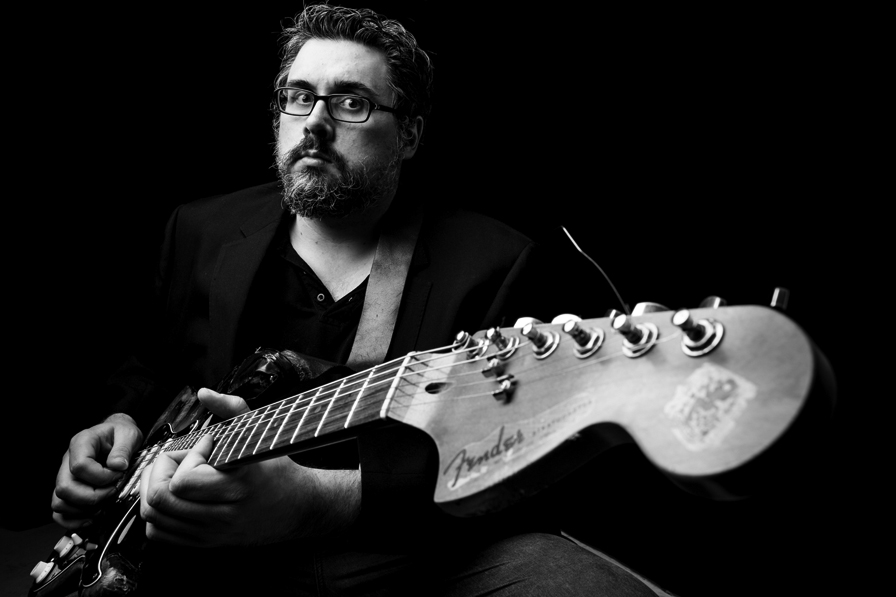
Matt Stevens is the epitome of the self-made musician. The British guitarist and composer exercises his creative muscles both through his art and his marketing. He’s known for his adventurous loop-based, solo acoustic guitar performances and recordings, as well as his role in the mercurial rock act The Fierce and the Dead. He’s also known for doing whatever it takes to get people to hear his music above the din of the increasingly overcrowded music marketplace.
For years, Stevens worked every form of social media available, incessantly flyered gigs all over his London hometown, and shook hands and chatted with hundreds of people at those shows. He also gave away his music for free on the Web in the mid-2000s before it became standard practice. In addition, he took every possible gig available to him, traveling across Britain for minimal or no pay, to get people's attention. The fact that Stevens brings enormous energy and passion to his performances—sometimes concentrating intently, sometimes leaping about with abandon—also helped ensure audiences took notice.
The hard work paid off significantly. He slowly, but surely built up a devoted worldwide following that appreciates the authentic voice he brought to their initial encounters.
Stevens’ tenacity also led to a global deal with Esoteric Recordings, who released Lucid, his 2014 solo album. His intent was to showcase the diverse musical universe he occupies and break away from his mostly one-man previous output. It shifts between high-octane rock, looping explorations, ambient pieces, and full-on prog and fusion explorations. It also includes contributions from drummer Pat Mastelotto, bassists Lorenzo Feliciati and Charlie Cawood, and keyboardists Jem Godfrey and Emmett Elvin.
The Fierce and the Dead remains Stevens’ other core focus. The group emerged out of sessions for his second solo album. Everyone involved quickly realized the chemistry at work was worthy of a major collaboration in its own right. The band focuses on interlocking guitar work between Stevens and Steve Cleaton, propelled by the kinetic rhythm section of bassist Kevin Feazey and drummer Stuart Marshall. The band has a dynamic punk-meets-prog sound, full of ferocity and intensity, yet played with finesse.
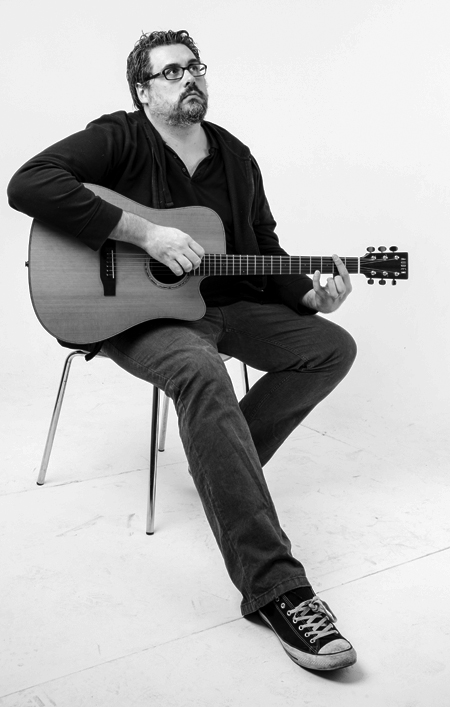
Lucid is incredibly diverse. Describe the thread you feel that holds it together.
Interesting chords are what hold it together. I remember listening to Mahavishnu Orchestra when I was a kid and it was their chord sequences that made the hairs on the back of my neck go up. There was an emotional element to their chords. That’s the thing I’m trying to get across with my music too. I want to get interesting harmony across. I’m not interested in flash playing. The emotional response is all I care about. I don’t care what people think of me as a guitar player.
The other thing about the album is that it’s about me trying new things. That’s how musicians get to the stuff that worked in the first place. The worst thing you can do is repeat what you’ve already done. I wanted to use the previous records with loops as a springboard and add different musicians, but not tell them what to play. I gave them the chords and told them to get on with it. The album features a broader canvas and is about forgetting what I’ve done in the past and trying to start again. I really feel artists need to shock themselves into doing new things and continually reinvent themselves.
It’s your first album with label backing. Did knowing it would reach a wider audience influence your choices on it?
In no way at all. Once you start worrying about what the audience thinks, you’re in a lot of trouble. I try to do things that are exciting and interesting to me. I don’t think about anybody else when I’m creating music. The compositions are written in a fairly deep emotional state. I’m focused on the art side, which is the enemy of the marketing side. I could have said “I’m going to make an album for a specific audience.” That might have done wonders for my career, but I can’t do it. I’d love to reach a wider audience, but it has to be based on what I would do anyway.
When I made the album, I had so much going on my life, including a new son and my work with The Fierce and the Dead, which is also constantly releasing new material. I remember getting to the end of Lucid and being really tired. I put so much into it. When you’ve got a family, the hours you put into a project have to really be worth it—and they were. The album means a lot to me. It’s only when I finished it that I wondered “What are people going to make of it? It’s all over the place. It has Mahavishnu Orchestra, King Crimson, jangly rock stuff, odd times, and interesting chords in it.” I wanted the album to have a broad range.
Describe your creative process.
I start with a chord sequence. It just sort of happens and I come up with something that I tinker around with for a bit. Eventually, I’ll get an arrangement together and try it with loops. Then I come up with a melody. If I want to bring other musicians in, I’ll find the right personalities and then not tell them what to do. There’s two schools of thought here. There’s the Zappa school in which you score everything and get people to do exactly what you want. There’s also the Miles Davis approach in which you get people, stick them in a room and off you go. I lean towards that. The act of composition is related to the choosing of people you have involved in the piece.
Pat Mastelotto and Lorenzo Feliciati perform on Lucid. They’re amazing players and I wanted to give them something quite interesting. I remember having the tune “The Ascent” together. I also wanted to have a Jan Hammer-style solo on it, so I got my friend Jem Godfrey on there who could do it. The choices of musicians are really related to the greater goal of the piece and the record as a whole. It’s not about having someone on there for the sake of it. It’s about having people who are going to do the job.
I also don’t want people who are going to play straight rock stuff. I want people who have an element of the independent rock sensibility. I want a looser feel from people I work with. Ideally, it’s people who can play in unusual time signatures but still have a bit of punk rock in their playing—a bit of Black Flag. It’s hard to find people like that. Pat and Lorenzo are people who have that energy while also being fantastic musicians.
You’ve said “Sometimes my limitations define me.” Elaborate on that.
It’s true. Let’s take loop pedals as an example. It’s really easy to do loop pedal composition. Your palette is quite limited and it forces you to come up with interesting harmonic ideas on the fly. It’s an act of creativity that falls between composition and improvisation. I take a sort of “What if Johnny Marr joined Mahavishnu Orchestra?” approach during this process. Within my head, I have things going on like “Where you have a jangly part or 30 different guitar parts playing interesting chord sequences, wouldn’t it be great to introduce a Steve Reich or Philip Glass thing in there?” I’m not actually specifically trying to do this, but rather it just happens because those influences are so deeply absorbed. I don’t listen to King Crimson a lot because it’s already in my head and I can reference it. So, that influence might make its way into something. I also intuitively understand which time signatures go together.
I think people can spend ages with Pro Tools, getting sounds and overdubbing. But I can’t do that when I’m using my own setup. I can do it later while I’m making a record during the production process. But when I’m working on music, those elements aren’t available to me.
What are the key challenges you face with this approach?
The main challenge is to keep things interesting. Another challenge is to constantly come up with new ideas. When I started, I was doing a lot of polyrhythm stuff. I felt every composition had to be different because I was a solo performer and had no band to rely on. No-one was carrying me. I was completely on my own and opening for professional rock bands with audiences looking at me going “So, what have you got?” I had to push myself to come up with material that would work in that context.
I’ve found that repetition can be fundamental to the act of composition—repeating things to the point where they start working. Sometimes, I’ll be sitting there with loops, stacking and stacking things, and thinking “That doesn’t work.” However, the process involves forcing myself into creative spaces and trying things out that may or may not go somewhere.
It’s very easy to play a chord sequence and then play overtop of it. I’ll do things like playing on different parts of the neck. I’m always trying to find something to say that is particular to the world of loops. There are some people that will play a jazz chord sequence and then play a jazz standard on top of it. Well, that’s not as good as a jazz band playing it, feeling it and edging the beat, so why do it? What’s the point? With loops, I try to do something that can’t possibly be performed any other way. There’s no reasonable way to have 30 guitarists improvising in a piece in front of an audience. So, that’s something you can do with looping that’s unique to it. You can do things that are impossible to do any other way.
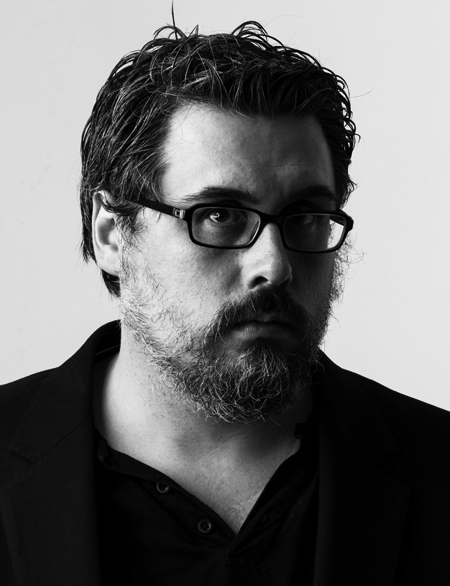
Assess the distance traveled since your 2008 debut album Echo.
When I first started out, I wanted to keep the records related to my live show. The Echo album is very much a live show album. My second album had a few bits of overdubbing and extra stuff. Echo had a lot of chord sequences and odd timings, with lots of inversions. The albums continue going forward. I’ve recontextualized things and absorbed different influences like minimalism, black metal and electronica, including Aphex Twin and Squarepusher. My evolution is also related to going around and playing live. The more you gig, the more you learn what works. Gigs can be weird as a solo artist. There may be one moment when I’m working in 13/8 and involved in a cascading effect that I find exciting. I’ll get lost in the moment and look out at the audience and realize they’re not interested in that bit. What they’re interested in is seeing my fingers move quickly. I couldn’t care less about moving my fingers quickly. That’s not where the magic is. The magic is where the harmony is reharmonizing with itself. I’m uninterested in being a virtuoso guitarist. But there are audiences that want to see the fingers move.
Looking back further, I started off very metal then I got into Mahavishnu Orchestra, King Crimson, Hüsker Dü, Bad Brains, The Smiths, Radiohead and Television via the KLF and Portishead. Somewhere in there I also got into Miles Davis and Joe Pass. It’s all had an impact. Having guitar lessons from someone who was very into unusual chords was really useful. If you’re playing anything other than the root note at the bottom of a chord, it’s already different to 99 percent of what most bands are doing. My tutor, Richard Beaumont, had me playing “Dance of Maya” by Mahavishnu Orchestra when most kids were learning “Sweet Child O’ Mine.” After that I spent most of my 20s playing in various London indie rock and metal bands. About 10 years ago, the band I was in split up and I was left with an acoustic guitar and a loop pedal and no transport, so solo guitar loop music seemed like a good plan. I could travel on the tube in London and do gigs. It was a practical solution. I was really into layered guitar like Johnny Marr and I wanted to combine that with the Mahavishnu-type chord progressions. No band I played with wanted to do that, so I thought I’d just do it myself.
Then Myspace, Twitter and social media came along and it gave me the opportunity to gain an audience. The popularity of the solo stuff allowed me to put a band together that had a cult audience ready made. We were able to go and explore lots of noisy rock stuff, and that’s how The Fierce and the Dead started. Getting back into playing electric guitar again after years of mostly playing acoustic changed my playing again and I’ve been focusing on developing that. There is so much left to do with the guitar, we’ve only just started.
What do you do if you’re performing and realize you’re facing a roomful of blank stares?
The things that really work live tend to be the bigger things. Composition is the thing that excites me, but performances can transcend that in a special way. Sometimes the audience is really with you, which is wonderful. I’ve had a very good reaction most of the time. But some of the very traditional rock audiences can be a bit challenging. When I’m in the mode of composing in real time, a jazz audience might pay more attention than a rock audience. But they don’t consider what I do to be proper jazz. And it’s not proper jazz. It’s not proper prog either. [laughs] People want niches. I enjoy performing to both audiences even though what I do doesn’t always fit in.
I remember when I did my first few gigs, I was really polite. I sat down with the guitar and did my thing. After a bit, I realized no-one was listening. I decided that after traveling five hours on a train to do a 35-minute gig, getting paid just enough to cover my train fare, that I want people to hear what I do. So, I went ahead and pushed it. Bob Mould was a big inspiration for me. The amount of passion he brings out live is exciting. I try and deliver that passion and inspiration based on the energy of punk bands.
For those who haven’t seen you perform, what can they expect at your show?
A big guy with a guitar jumping up and down. [laughs] I push myself to the point where I have no energy left when I come off stage. I want to be drenched in sweat. I put everything I’ve got into the show. It’s the same thing I expect from artists I see. I want to see them put everything into their gigs. If that’s not happening, why are you even on stage? It can be contextual. If you’re a jazz artist, you’re not selling a physical act. It’s more focused on the meditative side. But if you’re in the rock realm and your time on stage is limited, you should put everything into your performance. Sometimes I see bands who spend hours working out presets on the computer, getting 50 keyboard sounds, and then go up on stage and there’s no passion or emotion in it.
For me, the very best gigs are when I’m on my knees and things are interesting and exciting, and then I look up, having forgotten the audience is even there, and realizing it’s really with you. The hardest gigs are when I’m doing something I think is intriguing and the audience doesn’t get it. I’ve had both things happen, but the more I push the performance, the bigger the reaction I get.
I’ve learned how to engage the audience more effectively than when I started. I remember supporting Fish a few years ago and his audience felt I was just playing backing tapes and didn’t get it. I watched people like the comedians Stewart Lee and Johnny Vegas, who would sometimes roll around on the floor to create a certain level of performance. I thought “Well, if that’s what it takes to get people to listen to music in 15/8 with inversions, perhaps that’s what I have to do.” So, I have fun with the act of performance. But if it ever got to the point where I felt that was the majority of the show, then I will have crossed a line and it would become completely pointless. So, it’s about creating a balance.
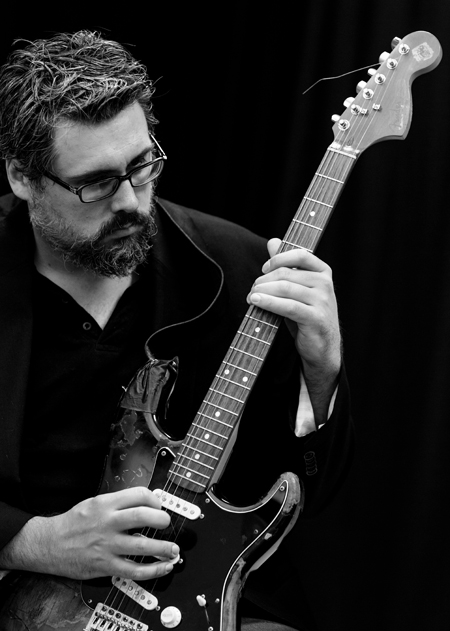
You’ve released several live recordings from your solo shows. What do you consider the key to making a live album that works as a long-term listening experience?
A live record needs to work as an honest document that captures the atmosphere of the performance. I’d rather hear the odd mistake and retain the energy than go back and re-record stuff. There are mistakes all over some of my favorite live records, but that’s just part of it. If you listen to those King Crimson live recordings from the ‘70s, there are moments where it gets messy, but that’s the most exciting bit.
Describe how you and Steve Cleaton work together and share guitar duties in The Fierce and the Dead.
There’s no lead or rhythm guitarist. There are also very few solos. It’s mostly about interlocking guitars. I might play a chord in one position and Steve will play a chord that’s not necessarily in the same time signature. It’s similar to the Robert Fripp and Adrian Belew idea. I’ve always been a bit worried about doing stuff like that, because there are a lot of people who rip off Fripp for a living. If Fripp’s done something, I want to do something else. It’s more about taking Fripp’s inspiration and using it to do something different.
The band’s music is about the relationship between the four players. I’ve known the guys for 20 years—since I was in school. We’re trying to take our punk and hardcore influences and mix them with Mahavishnu and King Crimson, but that’s looking at the music afterwards. We’ve done a couple of albums and have been well-received at some proggy festivals. There’s a lot of passion. We put on quite an aggressive rock show. At some of these prog events, some people go “What the bloody hell is this?” It’s a recontextualization of something you might see at a punk rock show, but punks don’t typically play inversions or chords in 13/8. So when you see the two things together in a prog concert, it’s unusual. When King Crimson came out with Discipline, many felt it was a new statement for rock. But people had done it before. It was just a recontextualization. I think in general, when people say something is new, what it usually is reflects taking an idea from one thing and moving it somewhere else. The band has real chemistry. Two of us can make eye contact and immediately play interesting parts that work together. It’s a great band.
You’ve mentioned Mahavishnu Orchestra and King Crimson several times. Why do these groups mean so much to you?
No-one has ever sounded like Mahavishnu Orchestra. The chords are so innovative and exciting. It was also a spiritual thing. They were a post-psychedelic band that widened the harmonic vocabulary significantly. The chords of “Hope” blow your head off. There’s such an atmosphere there as things ascend in it. King Crimson also has real magic. At the end of “Starless,” when they bring back the melody, they’ve opened the gates there. It was all about intensity, passion and being in the zone with these bands—the things I consider important in what I do as well.
Describe how you used social media during its early days to propel your career.
In 2006, I started posting music on the Internet and gradually made friends with bloggers and podcasters that are interested in music. It was the beginning of social media. Myspace was the hip and happening thing then. I was more surprised than anyone when I realized there was an opportunity. I had just turned 30 and been playing in bands since I was a kid. There wasn’t a prog or weird music scene back then. I was performing in indie rock, punk and metal bands playing what were perceived as “wrong chords,” inversions and doing third-from-the-root stuff, because I was into both Voivod and King Crimson.
What I realized is that online, my music had an appeal to people with all sorts of different tastes. It crossed over and started appearing in acoustic podcasts and indie blogs. It was never a prog-related thing then. Gradually, people adopted the music and told their friends. I encouraged everyone to download my music free of charge because I just wanted people to hear it. I wanted to remove all the barriers to my music. I’m not a believer in the idea that music should be free. But in the initial stages, you have to do what you have to in order to get people to listen.
What many people don’t understand is that promoting music can cost a lot of money. It can cost thousands of dollars to properly promote an indie album and build relationships in a more traditional way. Well, I didn’t have thousands of dollars, so I did it another way. Twitter and Facebook were also in their early days back then. There was a real window there in which you could create interest, but that opportunity is gone now. Everybody is doing it. It’s just the way you sell a record today.
In parallel with your social media efforts, you relentlessly flyered gigs. Expand on what you did and its benefit.
I flyered everything. I did it all myself, shook hands with everyone and made friends with many people. Many remembered that. People still come up to me now and say they recall meeting me in line somewhere. It’s something that’s stuck with them. Back then, I’d flyer gigs by acts like IQ and Steven Wilson. I would go up to the queue and hand each person a flyer. I thought it was a fantastic marketing idea. People took an interest and started coming out to the gigs.
I think you really have to work hard to make an impression these days. It’s never been more difficult. We’re in an interesting time. I’m concerned that having a band could mostly become a middle- to upper-class pursuit. I think there are quite a few people who establish bands just because they have the money. Could there have been a Black Sabbath today? They couldn’t have afforded to make an album or establish themselves without record company support. As much as we malign labels, the fact is some of them have marketing and business skills which enabled the artists to just make the records and perform. A band like Black Sabbath only broke through because of that investment. Now, a lot of the only people that can afford to tour are people who have a lot of money and can “buy” a band and perform with it in between their Grand Prix racing and yachting. I’ve got nothing against people with money, but they’re not necessarily the best or most interesting musicians.
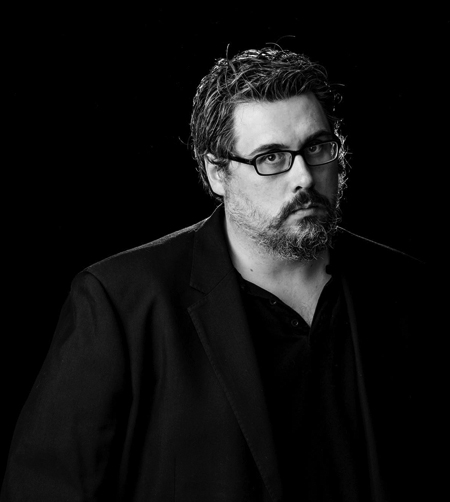
What’s in the future release pipeline for you?
I’m working on a third Fierce and the Dead album at the moment. It’s already sounding different from the last one. We’re incorporating bigger riffs and more of an electronic thing. I’ve got a few ideas for a new solo record, but that’s something for later in the future. I’ll only do it if it represents something new that I find inspiring and exciting—maybe something that puts it in a completely different context like alongside a string quartet or some of the minimal electronic stuff I’m listening to at the moment.
I’ve also written a song with Judy Dyble. We met awhile back through Myspace. She’s brilliant, very easy to work with and her voice is so distinctive. I’d been a fan of her work for a long time and seeing her live with her wonderful band was a bit of a revelation. It was very intimate and musical. Working with her was really a case of combining my unusual chords and voicings with her voice. It was really straightforward. We’re working out how to release the song at the moment. We’re both really pleased with it.
Pursuing these different directions is related to what I’ve read by Robert Anton Wilson, the philosopher who talked about "reality tunnels." He said you have to keep shifting to ensure things keep working. You can’t go back to Narnia the same way twice. You have to try new things.
What’s your perspective on streaming companies and the compensation levels they’re offering artists?
Streaming makes it very difficult for cult bands who sell 1,000 copies of each release. If 1,000 people stream an album 10 times, we probably make a few pennies versus 1,000 download or CD sales which create a model that will pay for modest recording expenses. At present, with CDs and downloads, it’s roughly sustainable, but not profitable. If we move to streaming and that income disappears completely, we’re in serious trouble. The frustrating thing is that some people think musicians are rich because of the image that some record labels like to portray about their artists. Some fans think we make loads of money touring, when the truth is that most of the people making weird, interesting music either tend to lose money—or at best—break even touring.
For me, it’s a case of thinking about how to change the business model, although I’m not sure quite how yet. I’m not massively keen on fan funding, as I think it creates difficult expectations between artists and fans. But my perspective is ever evolving. I’m not saying I won’t do a fan-funding campaign in the future. Even Sony is using Kickstarter to fund video games now. It’s only a matter of time before major labels use it to fund bands.
Another thing I should say is that there are some real positives that have emerged with these new platforms. Artists can now have a direct relationship with fans at any level they want. When I was a kid in the late ‘80s and early ‘90s, musicians were Gods or from another planet. They weren’t to be communicated with. I could no more meet a famous musician than I could meet Superman. But the relationships have completely changed, mostly for the better, with the fans being part of an ongoing conversation.
Is there a spiritual component to music for you?
It’s something I’ve investigated quite a lot recently. I had a period of being very depressed for awhile and I think my focus on music kept me sane. I’ve learned that the power of thought and the investment of passion into music is very worthwhile. When people talk about happiness, they often reference flow, Zen and being totally in the moment. I think those are all important ideas. My belief is that the future is a series of things that could happen and the past is a series of vaguely-remembered things that may or may not be true. All we really have is the moment. Being in that moment through music is magical. The act of composition in which you open up and your head just explodes is such a transcendent thing. It’s where I always want to go. In that way, music is totally spiritual. Music opens doors you can’t open any other way. My goal is to be able to have my listeners experience that through my music.
Photos by Ashley Jones